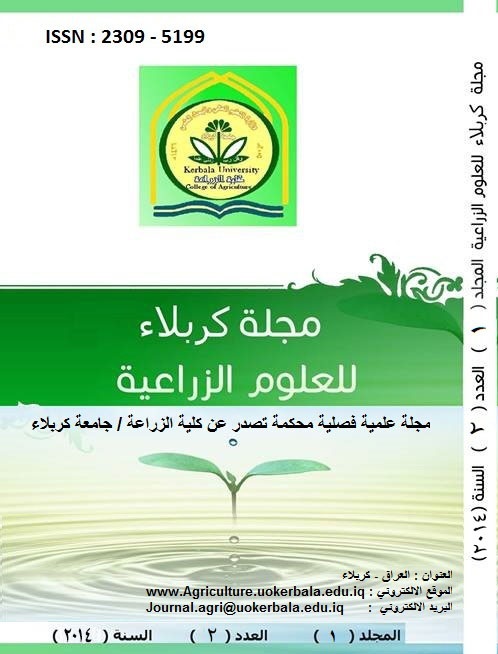Response of some varieties of bread wheat (Triticum astivim L.) and durum (Triticum durum L.) to salt stress
DOI:
https://doi.org/10.59658/jkas.v1i2.355Abstract
Experiment was conducted in Petri dishes and in the field (in the Baghdad / Abu Ghraib in the soil of calcareous classified within the range of soils Great Typic Torrifluvent) in order to study the effect of salinity stress( 3, 6 and 9 ds / m )in germination and dry weight at seedling and booting stages for two genotypes of bread wheat and two genotypes of durum wheat. Moreover the leaves and roots content of Na and K was estimated. use randomized complete block design in a factorial experiment with three replications .
The results showed the superiority Iraq genotypes among the varieties and sin al-jamal from durum genotypes in the percentage of germination , also caused increased levels of salinity stress to reduce germination in all varieties under study , while the cultivar gave Iraq varieties of bread genotype and sin al-jamal from durum genotypes lowest rate of decline . It also contained the upper leaves of these two categories on the lower concentration of sodium and the highest concentration of potassium , while their leaves contained the lower roots and the highest concentration of sodium, with the highest concentration of potassium in the lower leaves compared with other varieties . It also gave the two types higher value of the dry weight of shoots in the two phases of seedling and booting stages. The experiment results show the success of the product was Iraq varieties and sin al-jamal of durum varieties to tolerance the salinity stress compared to other varieties studied through possess a mechanism to exclude sodium in the lower parts and keep focus High potassium in different parts of the plant to maintain the ionic balance in the plant , which is likely to be considered efficient varieties to tolerance salinity stress .
Downloads
Published
How to Cite
Issue
Section
License
Copyright (c) 2014 Copyright (c) 2024 is the Author's article. Published by the Journal of Kerbala for Agricultural Sciences under a CC BY 4.0 license

This work is licensed under a Creative Commons Attribution 4.0 International License.
Licensing Terms
All articles are published under a Creative Commons License and will be directed to the Creative Commons Attribution 4.0 International License (CC BY 4.0) That permits use, distribution, and reproduction in any medium, provided the original work is properly cited. This license also allows the work to be used for commercial purposes.
Use by both non-commercial and commercial users
This content is licensed under a Creative Commons Attribution 4.0 International (CC BY 4.0) license, permitting use by both non-commercial and commercial users. Individual users may access, download, copy, display, and redistribute the articles to colleagues, as well as adapt, translate, and text- and data-mine the content, subject to the following conditions:
- The author's moral rights, including the right of attribution and the right to protect their work from derogatory treatment, are respected.
- Where content in the article is identified as belonging to a third party, users must ensure that any reuse complies with the copyright policies of the owner of that content.
- If the article content is reused for research or educational purposes, users should maintain a link to the appropriate bibliographic citation, including the DOI and a link to the published version on the journal's website.

